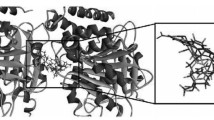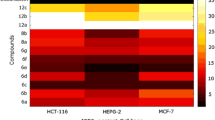Abstract
Complexes [Ga(2Ac4pFPh)2]NO3 (1), [Ga(2Ac4pClPh)2]NO3 (2), [Ga(2Ac4pIPh)2]NO3 (3), [Ga(2Ac4pNO2Ph)2]NO3·3H2O (4) and [Ga(2Ac4pT)2]NO3 (5) were obtained with 2-acetylpyridine N(4)-para-fluorophenyl-(H2Ac4pFPh), 2-acetylpyridine N(4)-para-chlorophenyl-(H2Ac4pClPh), 2-acetylpyridine N(4)-para-iodophenyl-(H2Ac4pIPh), 2-acetylpyridine N(4)-para-nitrophenyl-(H2Ac4pNO2Ph) and 2-acetylpyridine N(4)-para-tolyl-(H2Ac4pT) thiosemicarbazone. 1–5 presented antimicrobial and cytotoxic properties. Coordination to gallium(III) proved to be an effective strategy for activity improvement against Pseudomonas aeruginosa and Candida albicans. The complexes were highly cytotoxic against malignant glioblastoma and breast cancer cells at nanomolar concentrations. The compounds induced morphological changes characteristic of apoptotic death in tumor cells and showed no toxicity against erythrocytes. 2 partially inhibited tubulin assembly at high concentrations and induced cellular microtubule disorganization, but this does not appear to be the main mechanism of cytotoxic activity.






Similar content being viewed by others
References
Arion VB, Jakupec MA, Galanski M, Unfied P, Keppler BK (2002) Synthesis, structure, spectrocopic and in vitro antitumor studies of a novel gallium(III) complex with 2-acetylpyridine. J Inorg Biochem 91:298–305
Bastos TO, Soares BM, Cisalpino PS, Mendes IC, Dos Santos RG, Beraldo H (2010) Coordination to gallium(III) strongly enhances the potency of 2-pyridineformamide thiosemicarbazones against Cryptococcus opportunistic fungi. Microbiol Res 165:573–577
Beraldo H, Gambino D (2004) The wide pharmacological versatility of semicarbazones, thiosemicarbazones and their metal complexes. Mini-Rev Med Chem 4:31–39
Bermejo E, Castiñeiras A, Dominguez R, Carballo R, Maichle-Moessmer C, Straehle J, West DX (1999) Preparation, structural characterization, and antifungal activities of complexes of group 12 metals with 2-acetylpyridine- and 2-acetylpyridine-N-oxide-4 N-phenylthiosemicarbazones. Z Anorg Allg Chem 625:961–968
Bernstein LR (1998) Mechanisms of therapeutic activity for gallium. Pharmacol Rev 50:665–682
Bernstein LR (2005) Therapeutic gallium compounds. In: Gielen Tiekink (ed) Metallotherapeutic drugs and metal-based diagnostic agents: the use of metals in medicine. Wiley, New York, pp 259–277
Bernstein LR, Tanner T, Godfrey C, Noll B (2000) Chemistry and pharmacokinetics of gallium maltolate, a compound with high oral gallium bioavailability. Met-Based Drugs 7:33–47
Byrd TF, Horwitz MA (1993) Regulation of transferrin receptor expression and ferritin content in human mononuclear phagocytes. Coordinate upregulation by iron transferrin and downregulation by interferon gamma. J Clin Invest 91:969–976
Chitambar CR (2004a) Gallium nitrate for the treatment of non-Hodgkin’s lymphoma. Expert Opin Investig Drugs 13:531–541
Chitambar CR (2004b) Apoptotic mechanisms of gallium nitrate: basic and clinical investigations. Oncology 18:39–44
Chitambar CR, Purpi DP (2010) A novel gallium compound synergistically enhances bortezomib-induced apoptosis in mantle cell lymphoma cells. Leuk Res 34:950–953
Collery P, Keppler B, Madoulet C, Desoize B (2002) Gallium in cancer treatment. Crit Rev Oncol Hematol 42:283–296
Da Silva JG, Azzolini LS, Wardell SMSV, Wardell JL, Beraldo H (2009) Increasing the antibacterial activity of gallium(III) against Pseudomonas aeruginosa upon coordination to pyridine-derived thiosemicarbazones. Polyhedron 28:2301–2305
Despaigne AAR, Parrilha GL, Izidoro JB, da Costa PR, dos Santos RG, Piro OE, Castellano EE, Rocha WR, Beraldo H (2012a) 2-Acetylpyridine- and 2-benzoylpyridine-derived hydrazones and their gallium(III) complexes are highly cytotoxic to glioblastoma cells. Eur J Med Chem 50:163–172
Despaigne AAR, Da Costa FB, Piro OE, Castellano EE, Louro SRW, Beraldo H (2012b) Complexation of 2-acetylpyridine- and 2-benzoylpyridine-derived hydrazones to copper(II) as an effective strategy for antimicrobial activity improvement. Polyhedron 38:285–290
Einhorn L (2003) Gallium nitrate in the treatment of bladder cancer. Semin Oncol 30:34–41
Enyedy EA, Primik MF, Kowol CR, Arion VB, Kiss T, Keppler BK (2011) Interaction of triapine and related thiosemicarbazones with iron(III)/(II) and gallium(III): a comparative solution equilibrium study. Dalton Trans 40:5895–5905
Farrugia LJ (1997) ORTEP-3 for Windows—a Version of ORTEP-III with a graphical user interface (GUI). J Appl Crystallogr 30:565
Farrugia LJ (1999) WinGX suite for single crystal small molecule crystallography. J Appl Crystallogr 32:837–838
Ferraro MJ, Wikler MA, Craig WA, Dudley MN, Eliopoulos GM, Hecht DW, Hindler J, Reller LB, Jr Sheldon AT, Swenson JM, Tenover FC, Testa RT, Weinstein MP, Ferraro MJ (2005) Method for dilution antimicrobial susceptibility test for bacteria that grow aerobically—approved standard-sixth edition, M7–A6. National Committee for Clinical Laboratory Standards, Villanova
Ferraz KSO, Ferandes L, Carrilho D, Pinto MCX, Leite MF, Souza-Fagundes EM, Speziali NL, Mendes IC, Beraldo H (2009) 2-Benzoylpyridine-N(4)-tolyl thiosemicarbazones and their palladium(II) complexes: cytotoxicity against leukemia cells. Bioorg Med Chem 17:7138–7144
Finch RA, Liu M, Grill SP, Rose WC, Loomis R, Vasquez KM, Cheng Y, Sartorelli AC (2000) Triapine (3-Aminopyridine-2-carboxaldehyde-thiosemicarbazone): a potent inhibitor of ribonucleotide reductase activity with broad spectrum antitumor activity. Biochem Pharmacol 59:983–991
Fisher D, Li Y, Ahlemeyer B, Krieglstein J, Kissel T (2003) In vitro cytotoxicity testing of polycations: influence of polymer structure on cell viability and hemolysis. Biomaterials 24:1121–1131
Jakupec MA, Keppler BK (2004) Gallium in cancer treatment. Curr Top Med Chem 4:1575–1583
Jordan MA (2002) Mechanism of action of antitumor drugs that interact with microtubules and tubulin. Curr Med Chem Anticancer Agents 2:1–17
Kaneko Y, Thoendel M, Olakanmi O, Britigan BE, Singh PK (2007) The transition metal gallium disrupts Pseudomonas aeruginosa iron metabolism and has antimicrobial and antibiofilm activity. J Clin Invest 117:877–888
Klayman DL, Bartosevich JF, Griffin TS, Mason CJ, Scovill JP (1979) 2-Acetylpyridine thiosemicarbazones. 1. A new class of potential antimalarial agents. J Med Chem 22:855–862
Kowol CR, Berger R, Eichinger R, Roller A, Jakupec MA, Schmidt PP, Arion VB, Keppler BK (2007) Gallium(III) and iron(III) complexes of α-N-heterocyclic thiosemicarbazones: synthesis, characterization, cytotoxicity, and interaction with ribonucleotide reductase. J Med Chem 50:1254–1265
Kowol CR, Trondl R, Heffeter P, Arion VB, Jakupec MA, Roller A, Galanski M, Berger W, Keppler BK (2009) Impact of metal coordination on cytotoxicity of 3-aminopyridine-2-carboxaldehyde thiosemicarbazone (triapine) and novel insights into terminal dimethylation. J Med Chem 52:5032–5043
Lessa JA, Mendes IC, da Silva PRO, Soares MA, dos Santos RG, Speziali NL, Romeiro NC, Barreiro EJ, Beraldo H (2010) 2-Acetylpyridine thiosemicarbazones: cytotoxic activity in nanomolar doses against malignant gliomas. Eur J Med Chem 45:5671–5677
Lessa JA, Reis DC, Mendes IC, Speziali NL, Rocha LF, Pereira VRA, Melo CML, Beraldo H (2011) Antimony(III) complexes with pyridine-derived thiosemicarbazones: structural studies and investigation on the antitrypanosomal activity. Polyhedron 30:372–380
Lessa JA, Parrilha GL, Beraldo H (2012) Gallium complexes as new promising metallodrug candidates. Inorg Chim Acta 393:53–63
Mendes IC, Soares MA, dos Santos RG, Pinheiro C, Beraldo H (2009) Gallium(III) complexes of 2-pyridineformamide thiosemicarbazones: cytotoxic activity against malignant glioblastoma. Eur J Med Chem 44:1870–1877
Nakamoto K (1986) Infrared and Raman spectra of inorganic and coordination compounds, 4th edn. Wiley, New York
Opletalova V, Kalinowski DS, Vejsová M, Kunes J, Pour M, Jampílek J, Buchta V, Richardson DR (2008) Identification and characterization of thiosemicarbazones antifungal and antitumor effects: cellular iron chelation mediating cytotoxic activity. Chem Res Toxicol 21:1878–1889
Perchellet EM, Ladesich JB, Collery P, Perchellet J (1999) Microtubule-disrupting effects of gallium chloride in vitro. Anticancer Drugs 10:477–488
Pfaller MA, Chaturvedi V, Espinel-Ingroff A, Ghannoum MA, Gosey LL, Odds FC, Rex JH, Rinaldi MG, Sheehan DJ, Walsh TJ, Warnock DW (2002) National Committee for Clinical Laboratory Standards, reference method for broth dilution antifungal susceptibility testing of yeasts, in: NCCLS Document M27eMA2 NCCLS. Pennsylvania, USA
Plumb JA, Miloroy R, Kaye SB (1989) Effects of the pH dependence of 3-[4,5-dimetiltiazol-2-il]-2,5-difenil-tetrazolium bromide-formazan absorption on chemosensitivity determined by a novel tetrazolium-based assay. Cancer Res 49:4435–4440
Rzhepishevska O, Ekstrand-Hammarström B, Popp M, Björn E, Bucht A, Sjöstedt A, Antti H, Ramstedt M (2011) The antibacterial activity of Ga3+ is influenced by ligand complexation as well as the bacterial carbon source. Antimicrob Agents Chemother 55:5568–5580
Shao J, Zhou B, Chu B, Yen Y (2006) Ribonucleotide reductase inhibitors and future drug design. Curr Cancer Drug Targets 6:409–431
Sheldrick GM (1997) SHELXL-97: program for crystal structures analysis. University of Göttingen, Göttingen
Soares MA, Lessa JA, Mendes IC, Da Silva JG, dos Santos TF, Salum LB, Daghestani H, Andricopulo AD, Day BW, Vogt A, Pesquero JL, Rocha WR, Beraldo H (2012) N 4-phenyl-substituted 2-acetylpyridine thiosemicarbazones: cytotoxicity against human tumor cells, structure-activity relationship studies and investigation on the mechanism of action. Bioorg Med Chem 20:3396–3409
Spek AL (2009) Structure validation in chemical crystallography. Acta Crystallogr D65:148–155
Straus DJ (2003) Gallium nitrate in the treatment of lymphoma. Semin Oncol 30:25–33
Vogt A, McPherson PA, Shen X, Balachandran R, Zhu G, Raccor BS, Nelson SG, Tsang M, Day BW (2009) High-content analysis of cancer-cell-specific apoptosis and inhibition of in vivo angiogenesis by synthetic (-)-pironetin and analogs. Chem Biol Drug Des 74:358–368
Wang Z, McPherson PA, Raccor BS, Balachandran R, Zhu G, Day BW, Vogt A, Wipf P (2007) Structure-activity and high-content imaging analyses of novel tubulysin. Chem Biol Drug Des 70:75–86
Wilder MA, Cockerill FR, Craig WA, Dudley MN, Eliopoulos GM, Hecht DW, Hindler JF, Low DE, Sheehan DJ, Tenover FC, Turnidge JD, Weinstein MP, Zimmer BL, Ferraro MJ, Swenson JM (2005) Clinical and Laboratory Standards Institute. Performance Standards for Antimicrobial Susceptibility Testing; Fifteenth Informational Supplement. CLSI document M100-S15 (ISBN 1-56238-556-9). Clinical and Laboratory Standards Institute, 940 West Valley Road, Suite 1400, Wayne, Pennsylvania 19087-1898, USA
Acknowledgments
This work was supported by CNPq and INCT-INOFAR (Proc. CNPq 573.364/2008-6). The authors express sincere thanks to LabCRI (UFMG), particularly to Professor Nilvado L. Speziali for the X-ray facilities and measurements.
Author information
Authors and Affiliations
Corresponding author
Electronic supplementary material
Below is the link to the electronic supplementary material.
Rights and permissions
About this article
Cite this article
Lessa, J.A., Soares, M.A., dos Santos, R.G. et al. Gallium(III) complexes with 2-acetylpyridine-derived thiosemicarbazones: antimicrobial and cytotoxic effects and investigation on the interactions with tubulin. Biometals 26, 151–165 (2013). https://doi.org/10.1007/s10534-012-9603-1
Received:
Accepted:
Published:
Issue Date:
DOI: https://doi.org/10.1007/s10534-012-9603-1




